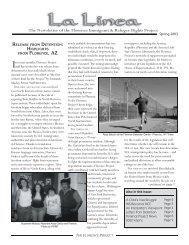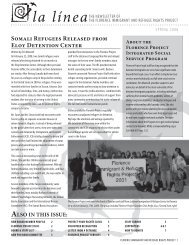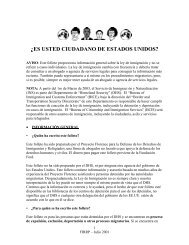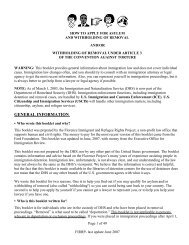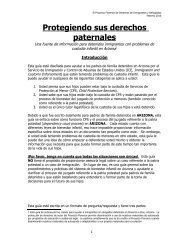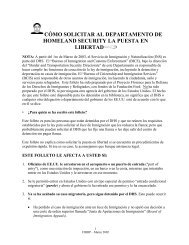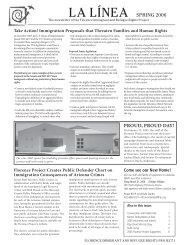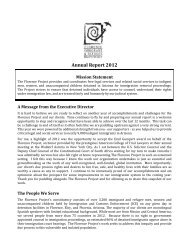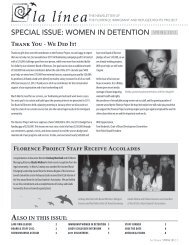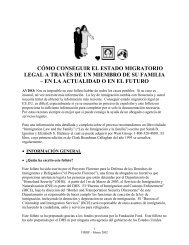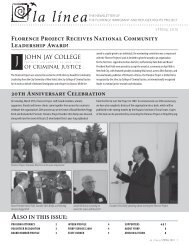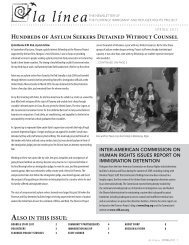quick reference chart and annotations for determining immigration ...
quick reference chart and annotations for determining immigration ...
quick reference chart and annotations for determining immigration ...
Create successful ePaper yourself
Turn your PDF publications into a flip-book with our unique Google optimized e-Paper software.
Immigrant Legal Resource Center, Florence Immigrant <strong>and</strong> Refugee Rights Project,<br />
Maricopa County Public Defender August 2012<br />
Aggravated Felony: Counsel should assume that a conviction <strong>for</strong> first-degree murder will be<br />
considered an aggravated felony as “murder” within 8 U.S.C. § 1101(a)(43)(A), regardless of the sentence<br />
imposed.<br />
Other grounds: If the record of conviction demonstrates a domestic relationship under A.R.S. §<br />
13-3601 or contains the age of the victim, a conviction <strong>for</strong> first-degree murder would likely also be<br />
removable under the grounds of domestic violence or child abuse, neglect, or ab<strong>and</strong>onment. Matter of<br />
Velazquez-Herrera, 24 I&N Dec. 503 (BIA 2008). Immigration counsel would have arguments against<br />
this if the age of the victim was not “actually required” in order to convict the defendant of the offense.<br />
United States v. Aguila-Montes de Oca, 655 F.3d 915, 940 (9th Cir. 2011) (en banc).<br />
9. Endangerment, A.R.S. §13-1201<br />
A person commits endangerment by recklessly endangering another person with a substantial risk of<br />
imminent death or physical injury. Endangerment involving a substantial risk of imminent death is a<br />
class 6 felony. In all other cases, it is a class 1 misdemeanor.<br />
Summary: Under current law this is not an aggravated felony even with a 365-day sentence.<br />
Still, as always counsel should attempt to get a sentence imposed of 364 days or less to prevent this from<br />
possibly being held an aggravated felony. Counsel also should follow guidance regarding the record of<br />
conviction, below.<br />
Crime Involving Moral Turpitude (CMT): Possibly, particularly if serious injury is<br />
threatened. No case law has yet defined whether endangerment is a crime involving moral turpitude, <strong>and</strong><br />
unpublished BIA case law has been mixed. ICE has been charging this as a CMT more frequently <strong>and</strong> it<br />
is possible that some <strong>immigration</strong> judges will find it to be so in light of case law suggesting that a mens<br />
rea of “recklessness” is sufficient to establish an offense as a CMT. See Matter of Silva-Trevino, 24 I&N<br />
Dec. 687 (A.G. 2008).<br />
Mere risk of injury or death—with no actual injury or other aggravating factor— gives<br />
<strong>immigration</strong> counsel an argument that the conviction is not a CMT. See Matter of Fualaau, 21 I&N Dec.<br />
475, 478 (BIA 1996). The BIA’s recent decision in Matter of Ruiz-Lopez, 25 I&N Dec. 551 (BIA 2011)<br />
supports this since a statute encompassing “endangerment-like” behavior was only found a CIMT when<br />
combined with the aggravating factor of fleeing a police officer. See also Uppal v. Holder, 576 F.3d<br />
1014 (9th Cir. 2009) (an assault statute not involving a specific intent to injure or a special trust<br />
relationship <strong>and</strong> not requiring that the assault cause death or even serious bodily injury cannot qualify as a<br />
categorical CIMT). Defense counsel should be conservative <strong>and</strong> try to keep the record vague, i.e. use<br />
boilerplate statutory language in the plea agreement, <strong>and</strong> avoid mentioning any aggravating factors such<br />
as injury, the age of the victim, or the circumstances of the offense.<br />
Even if it is a CMT, a single class 1 misdemeanor conviction would not cause deportability or<br />
inadmissibility. Recklessly causing substantial risk of imminent death may be more likely a CMT.<br />
Aggravated Felony: No. Under Ninth Circuit law, a mens rea of recklessness is insufficient to<br />
meet the definition of a “crime of violence.” Fern<strong>and</strong>ez-Ruiz v. Gonzales, 466 F.3d 1121 (9th Cir. 2006)<br />
(en banc) (recklessly causing physical injury to another does not meet the federal definition of a “crime of<br />
violence” under 18 U.S.C. § 16); Flores-Lopez v. Holder, 685 F.3d 857 (9th Cir. 2012) (Cali<strong>for</strong>nia<br />
“general intent” crime that employs a mens rea of recklessness is not categorically a “crime of violence”<br />
Arizona Criminal Chart with Explanatory Endnote – August 2012<br />
20



